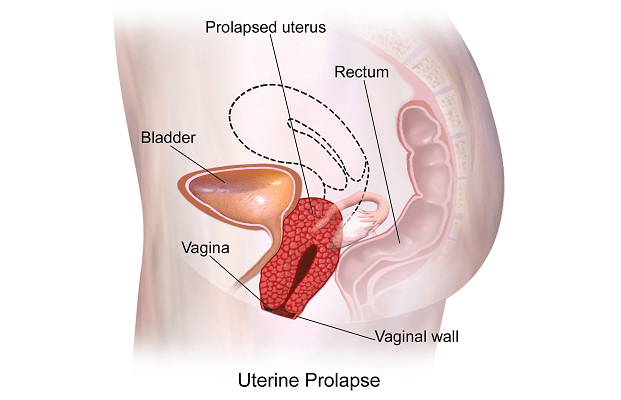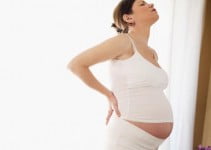 Pregnancy complications most times are dreadful experiences. These complications may occur at various stages of the pregnancy and are of various degrees.
Pregnancy complications most times are dreadful experiences. These complications may occur at various stages of the pregnancy and are of various degrees.
Preventive measures are always the best way to avoid such complication. However, if you ever run into one of these, do best to start an early treatment. This article discusses uterine prolapse as a pregnancy complication.
What is uterine prolapse?
Uterine prolapse (aka uterus displacement/ womb displacement or procidentia) occurs when the uterus (womb) sags or slips out of its natural position into the birth canal (vagina).
The uterus (womb) is an organ of the female reproductive system made up of flexible muscular tissues, suspended in place by muscles and ligaments which are susceptible to stretch during pregnancy or other conditions and become weak and unable to support the weight of the uterus causing a prolapse.
The prolapse may be incomplete or complete. Incomplete prolapse occurs if there is a partial sag into the vagina, while a complete prolapse occurs when the uterus protrudes far down the vagina (Uterovaginal prolapse).
According to Floridahospital.com, statistical data shows that 44percent of women in the US suffer from uterine prolapse, 14% of that ratio have a complete prolapse.
Another study shows 11% of a woman whose body mass index is greater than 35 have a higher risk of suffering from uterine prolapse.
For the records, 95% of hysterectomies in the U.K occur due to prolonged uterine prolapse.
The symptoms of uterine prolapse include:
- An uneasy feeling that something is coming down or out of the vagina
- An uncomfortable and unnatural feeling of fullness in and around the pelvic region
- Experiencing pain or difficulty during lovemaking
- Stress incontinence; leaking of trace amounts of urine when you sneeze, cough, laugh or exercise.
Causes
Uterine prolapse is caused by some factors, below are some common ones:
- Pregnancy or childbirths with normal or complicated vaginal delivery. Women who have records of some vaginal births, say 5-7 kids are at risk of having uterine prolapse
- Weakness in the pelvic muscles caused mostly by advancement in age. Most prolapses occur at a woman’s later years when walls of the womb and ligaments are lax and saggy.
- Weakening and loss of tissue tone after menopause and decreased levels of natural estrogen. The risk of having a prolapsed uterus increases as a woman approaches menopause and her estrogen levels decrease. The hormone estrogen helps to maintain the health of the pelvic muscles.
- Conditions which cause increased pressure in the abdomen, are a significant trigger. Conditions such as a chronic cough (with bronchitis and asthma), straining (with constipation), pelvic tumors (rare), or an accumulation of fluid in the abdomen such as constipation. Being overweight or obese can cause additional strain on pelvic muscles thereby resulting in uterine prolapse.
- Major surgery in/around the pelvic region causing to loss of external support.
- Smoking
Precautions
To prevent prolapse of the uterus:
- Ease of the stress on the pelvis region by carrying out household chores in a sitting position, of course, this applies to only a few errands.
- Do regular kegel, yoga and ayurvedic exercises to maintain the tone of pelvic muscles
- Support your lower back with a pillow when resting after meals
- Always check on your body weight. Obese women are more likely to witness uterine prolapse
- Stay away from lifting heavy weights to avoid putting undue pressure on the abdomen.
- Avoid smoking. Smoking tends to aggravate symptoms of prolapse
- Monitor your uterus with regular physical pelvic examination using a speculum(a medical device) combined with palpation of the abdomen (Palpation is the examination of the abdomen for crepitus of the abdominal wall, for any abdominal tenderness, or for abdominal masses)
- Women undergoing menopause or above 55 years of age, with a prolapse concern may consider undergoing estrogen replacement therapy (ERT).
- During labor, avoid pushing until the baby is way down through the birth canal. You may feel the irresistible urge to push, but not that labor contractions will help move the baby down for you, nature has its ways remember. So, save that energy and prevent the occurrence of prolapse by breathing through contractions. Only push when your body tells you to.
Note, having an epidural increase the chance of prolapse as you may not be able to feel when to push. It is best to follow the instruction of the health care providers and only push when they ask you to.
Treatments
The treatment for uterine prolapse is usually centered on strengthening the vaginal tissues and aiming for its tissue regeneration.
The use of vaginal estrogen helps to augment other treatment options and promote the overall health of the vagina.
On the other hand, it is important to note that estrogen treatment does not reverse the current state/ presence of a prolapse instead it serves as a management option in minor cases.
For women suffering from a complete prolapse, the only treatment option is corrective surgery.
The surgery depends on the extent of the prolapse and can range from uterine suspension to hysterectomy, after which a vaginal fixation surgery is performed to get the vagina back to its normal state.
During the uterine suspension, the medical team returns the uterus back to its normal position by suturing uterus in its place (Sacrocolpopexy)
A hysterectomy is the complete removal of the uterus from the body through the vagina or the abdomen. This option is only recommended if the prolapse is prolonged and detrimental to the health of the woman.
The use of vaginal pessary is one recommended option for treatment of first stage uterine prolapse and prevention during pregnancy.
The vaginal pessary is inserted into the vagina and rests on the walls of the birth canal, providing support for the womb.
The woman is expected to have a scheduled check-up to determine if the pressures are helping to strengthen the womb support or not.
In conclusion, uterine prolapse can occur in pregnant woman especially during the old age. However, the time of its occurence depends on how careful you are about it during pregnancy and afterward.
As long as you take precautions and do regular exercises, you are good to go!
Image source: wikimedia



